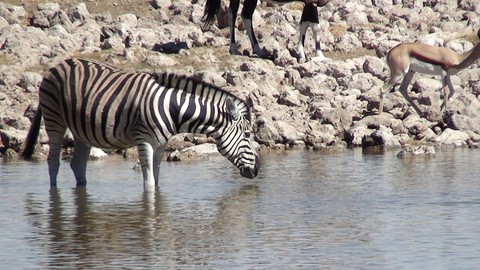
Animal Physiology 4: Temperature, heat and water balance
Animal Physiology 4: Temperature, heat and water balance, available at $54.99, has an average rating of 4.83, with 49 lectures, based on 9 reviews, and has 147 subscribers.
You will learn about Understand how temperature affects animals' metabolism Understand how enzymes are engineered to function well at a particular temperature Understand how to calculate the energy cost of homeostasis Understand the concept of the operative temperature and how it relates to the thermal niche Understand the energetic foundation of biogenetic rules such as Bergmann's rule Understand the concept of the thermal energy budget and how it shapes the nature of adaptation to environmental temperature Understand the role of evaporation from the skin and lungs in adaptation of animals to hot environments Understand some of the mechanism for reducing or recovering water lost by evaporation from the skin or lungs Understand how heat capacity of the body can be used as an adaptive mechanism for reducing evaporation losses in hot climates Understand the nature of adaptive challenges of cold environments Understand how animals manage freezing of body water, including antifreeze mechanisms and controlled freezing Understand the effect of cold on cell membrane fluidity and how membrane fluidity is managed in cold conditions Understand the fundamental energetic constraints that promote hibernation and torpor among animals Understand the concept of the water budget and how this ties in to adaptation to different hydric environments Understand the different types of hydric environments and the water balance challenges each poses Understand the basic mechanism of kidney function and the roles of filtration, reabsorption and secretion Understand how nephron function is managed and the relationship of salt recovery from water recovery Understand the basic hormonal control systems for kidney function, including the renin-angiotensin system and anti-diuretic hormone Understand how nephron morphology relates to kidney function and the changes in nephron morphology that have accompanied the transition to terrestrial life Understand the adaptive conflict between salt recovery and water recovery in terrestrial environments and some of the ways animals manage it, including salt glands Understand how the nitrogenous waste products of amino acid metabolism tie into the water budget of animals Understand how the kidneys of mammals and birds produces urine that is more concentrated than the blood and why the nephrons of the lower vertebrates cannot Understand the Malphighian tubule system of insects and how these illustrate the different ways animals meet the same adaptive challenges This course is ideal for individuals who are This course is aimed at the upper-division and graduate student in the life sciences. or Practicing professionals in the life sciences looking for a brush-up course in animal physiology or Anyone interested in the nature and workings of biological adaptation It is particularly useful for This course is aimed at the upper-division and graduate student in the life sciences. or Practicing professionals in the life sciences looking for a brush-up course in animal physiology or Anyone interested in the nature and workings of biological adaptation.
Enroll now: Animal Physiology 4: Temperature, heat and water balance
Summary
Title: Animal Physiology 4: Temperature, heat and water balance
Price: $54.99
Average Rating: 4.83
Number of Lectures: 49
Number of Published Lectures: 49
Number of Curriculum Items: 49
Number of Published Curriculum Objects: 49
Original Price: $19.99
Quality Status: approved
Status: Live
What You Will Learn
- Understand how temperature affects animals' metabolism
- Understand how enzymes are engineered to function well at a particular temperature
- Understand how to calculate the energy cost of homeostasis
- Understand the concept of the operative temperature and how it relates to the thermal niche
- Understand the energetic foundation of biogenetic rules such as Bergmann's rule
- Understand the concept of the thermal energy budget and how it shapes the nature of adaptation to environmental temperature
- Understand the role of evaporation from the skin and lungs in adaptation of animals to hot environments
- Understand some of the mechanism for reducing or recovering water lost by evaporation from the skin or lungs
- Understand how heat capacity of the body can be used as an adaptive mechanism for reducing evaporation losses in hot climates
- Understand the nature of adaptive challenges of cold environments
- Understand how animals manage freezing of body water, including antifreeze mechanisms and controlled freezing
- Understand the effect of cold on cell membrane fluidity and how membrane fluidity is managed in cold conditions
- Understand the fundamental energetic constraints that promote hibernation and torpor among animals
- Understand the concept of the water budget and how this ties in to adaptation to different hydric environments
- Understand the different types of hydric environments and the water balance challenges each poses
- Understand the basic mechanism of kidney function and the roles of filtration, reabsorption and secretion
- Understand how nephron function is managed and the relationship of salt recovery from water recovery
- Understand the basic hormonal control systems for kidney function, including the renin-angiotensin system and anti-diuretic hormone
- Understand how nephron morphology relates to kidney function and the changes in nephron morphology that have accompanied the transition to terrestrial life
- Understand the adaptive conflict between salt recovery and water recovery in terrestrial environments and some of the ways animals manage it, including salt glands
- Understand how the nitrogenous waste products of amino acid metabolism tie into the water budget of animals
- Understand how the kidneys of mammals and birds produces urine that is more concentrated than the blood and why the nephrons of the lower vertebrates cannot
- Understand the Malphighian tubule system of insects and how these illustrate the different ways animals meet the same adaptive challenges
Who Should Attend
- This course is aimed at the upper-division and graduate student in the life sciences.
- Practicing professionals in the life sciences looking for a brush-up course in animal physiology
- Anyone interested in the nature and workings of biological adaptation
Target Audiences
- This course is aimed at the upper-division and graduate student in the life sciences.
- Practicing professionals in the life sciences looking for a brush-up course in animal physiology
- Anyone interested in the nature and workings of biological adaptation
Animal physiology is, to use a common phrase, how animals work.�
Animals are, in one sense, machines, and the aim of the science of
physiology is to understand how these machines function—what drives
them, how they operate, the interaction of the various systems they
comprise, and the physical and chemical constraints on how they work.�
Animals are also organisms, and this course is intended to help you understand how animals work as integrated units, i.e.
as organisms. We will be concerned with how organisms’ various
components work to keep an animal alive, with how these are coordinated,
and how the various types of animals, despite their disparate
evolutionary histories, solve common physiological problems, sometimes
in remarkably innovative ways.
This course is the fourth in a series of courses that, together, would
be the equivalent of a one-semester course in animal physiology. I
strongly recommend that you take the first two courses in the series, Animal Physiology 1. Respiration and gas exchange, Animal Physiology 2. Blood and circulation,and Animal Physiology 3: Digestion and metabolism before you take this course. .�
This course is intended for the upper-division biology student. It is
also a good course for graduate students and practicing professionals
looking for a brush-up course in animal physiology. I presume that you
come into this course with the background in chemistry, physics,
mathematics and biology that can be reasonably expected of a senior
biology student.
The course consists of about six hours of video clips, parceled into seven lectures.
Course Curriculum
Chapter 1: Introduction to Animal Physiology 4: Temperature, heat and water balance
Lecture 1: Introduction to Animal Physiology 4: Temperature, heat and water balance
Chapter 2: Lecture 21 Temperature adaptation
Lecture 1: Lecture 21 Intro. Temperature
Lecture 2: Lecture 21_1 Temperature
Lecture 3: Lecture 21_2 Fourier's Law
Lecture 4: Lecture 21_3 The Scholander model
Lecture 5: Lecture 21_4 Scaling of thermal conductance
Lecture 6: Lecture 21_5 The thermal conductance
Lecture 7: Lecture 21_6 Bergmann's Rule 1
Lecture 8: Lecture 21_7 Bergmann's Rule 2
Chapter 3: Lecture 22 Temperature and reaction kinetics
Lecture 1: Lecture 22 Intro. Temperature & reaction kinetics
Lecture 2: Lecture 22_1 Temperature and reaction kinetics
Lecture 3: Lecture 22_2 Adaptation in reaction kinetics
Lecture 4: Lecture 22_3 Thermal limits on reaction kinetics
Lecture 5: Lecture 22_4 The thermal niche
Lecture 6: Lecture 22_5 Operative temperature and the thermal niche
Chapter 4: Lecture 23 Adaptation to extreme temperatures
Lecture 1: Lecture 23 Intro. Adaptation to extreme temperatures
Lecture 2: Lecture 23_1 Adaptation to extreme temperatures
Lecture 3: Lecture 23_2 Cutaneous evaporation
Lecture 4: Lecture 23_3 Respiratory water loss
Lecture 5: Lecture 23_4 Respiratory water vapor recovery
Lecture 6: Lecture 23_5 Regional heterothermy
Chapter 5: Lecture 24 Adaptation to cold
Lecture 1: Lecture 24 Intro. Adaptation to cold
Lecture 2: Lecture 24_1 Adaptations to cold
Lecture 3: Lecture 24_2 Homeoviscous adaptation
Lecture 4: Lecture 24_3 Freezing
Lecture 5: Lecture 24_4 Torpor
Lecture 6: Lecture 24_5 Hibernation
Lecture 7: Lecture 24_6 Thermogenesis
Chapter 6: Lecture 25 Water balance
Lecture 1: Lecture 25 Intro. Water balance
Lecture 2: Lecture 25_1 Water balance
Lecture 3: Lecture 25_2 Osmosis
Lecture 4: Lecture 25_3 The nephron
Lecture 5: Lecture 25_4 Filtration
Lecture 6: Lecture 25_5 Reabsorption
Lecture 7: Lecture 25_6 Secretion
Chapter 7: Lecture 26 Urine production
Lecture 1: Lecture 26 Intro. Urine production
Lecture 2: Lecture 26_1 Urine production
Lecture 3: Lecture 26_2 Hormonal control of urine production
Lecture 4: Lecture 26_3 The renin-angiotensin system
Lecture 5: Lecture 26_4 Handling of excess salt
Chapter 8: Lecture 27 Water
Lecture 1: Lecture 27 Intro. Water
Lecture 2: Lecture 27_1 The kidneys of the higher vertebates
Lecture 3: Lecture 27_2 Urine concentration
Lecture 4: Lecture 27_3 Kidney adaptation
Lecture 5: Lecture 27_4 Urine reduction in reptiles
Lecture 6: Lecture 27_5 The Malphighian tubules
Lecture 7: Lecture 27_6 Water balance and nitrogen metabolism
Lecture 8: Lecture 27_7 Adaptation & nitrogenous waste
Chapter 9: Animal Physiology 4 Review and Wrap-up
Lecture 1: Animal Physiology 4 Review and Wrap-up
Instructors
-
Scott Turner
Physiologist, Scientist, Writer, Media Maker
Rating Distribution
- 1 stars: 0 votes
- 2 stars: 0 votes
- 3 stars: 0 votes
- 4 stars: 2 votes
- 5 stars: 7 votes
Frequently Asked Questions
How long do I have access to the course materials?
You can view and review the lecture materials indefinitely, like an on-demand channel.
Can I take my courses with me wherever I go?
Definitely! If you have an internet connection, courses on Udemy are available on any device at any time. If you don’t have an internet connection, some instructors also let their students download course lectures. That’s up to the instructor though, so make sure you get on their good side!
You may also like
- Best Investing Courses to Learn in March 2025
- Best Personal Finance Courses to Learn in March 2025
- Best Health And Wellness Courses to Learn in March 2025
- Best Chatgpt And Ai Tools Courses to Learn in March 2025
- Best Virtual Reality Courses to Learn in March 2025
- Best Augmented Reality Courses to Learn in March 2025
- Best Blockchain Development Courses to Learn in March 2025
- Best Unity Game Development Courses to Learn in March 2025
- Best Artificial Intelligence Courses to Learn in March 2025
- Best Flutter Development Courses to Learn in March 2025
- Best Docker Kubernetes Courses to Learn in March 2025
- Best Business Analytics Courses to Learn in March 2025
- Best Excel Vba Courses to Learn in March 2025
- Best Devops Courses to Learn in March 2025
- Best Angular Courses to Learn in March 2025
- Best Node Js Development Courses to Learn in March 2025
- Best React Js Courses to Learn in March 2025
- Best Cyber Security Courses to Learn in March 2025
- Best Machine Learning Courses to Learn in March 2025
- Best Ethical Hacking Courses to Learn in March 2025






















